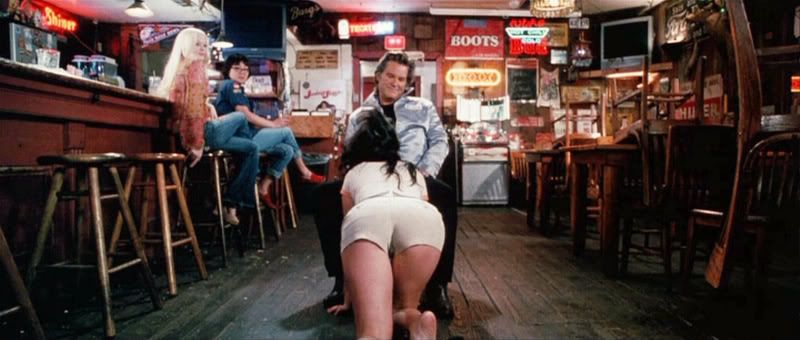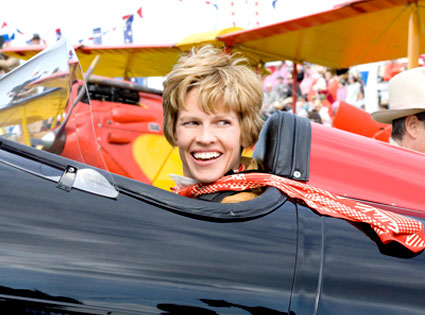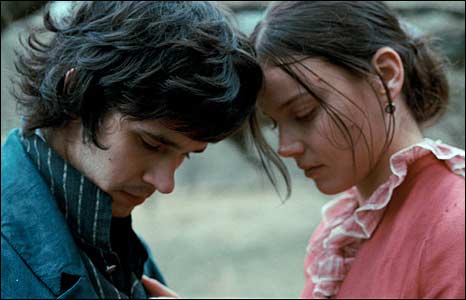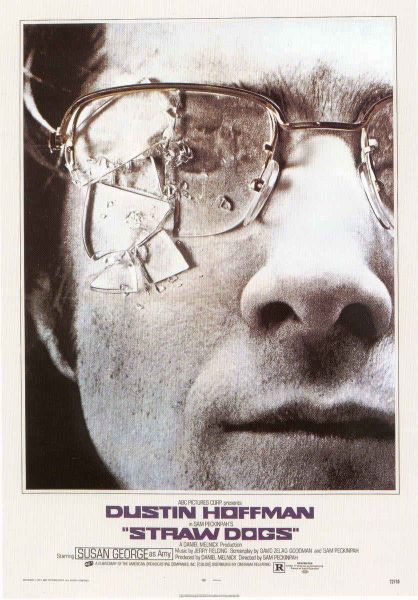This is an essay I wrote for a Road Movie class in 2008. Enjoy!

Quentin Tarantino loves women. Of the six films he’s made to date, four of them have female protagonists who star in films that deal very directly with womanly plights. Tarantino’s
Jackie Brown (1997) expresses the frustration of an aging black woman who has bared the brunt of society’s turmoil and builds a better life for herself.
Kill Bill vol. 1 (2003) makes a woman’s choice to retire from her job in the manly world of professional killing to raise a family seem wrong because she is so skilled at her job. And, in
Kill Bill vol. 2 (2004), the main character realizes she can have both her job and her family and still be happy. However, it is in his latest venture,
Death Proof (2007), that Quentin Tarantino both out-do’s and out-don’ts himself by juxtaposing eight different women with each other under the watchful eye of both feminism and the road movie genre conventions. Quentin Tarantino’s
Death Proof is a kick ass woman’s picture that has a lot to say without a lot of ways of saying it.
The film tells the tale of two sets of girls who encounter a man with a “death proof” car by the name of Stuntman Mike (Kurt Russell). The first group of girls, Butterfly/Arlene (Vanessa Ferlito), Julia (Sydney Poitier), Shanna (Jordan Ladd), and, to a lesser extent, Pam (Rose MacGowan) are a group of gal pals who suffer the wrath of Stuntman Mike and his misogynistic tendencies because they succumb and accept the lifestyle bestowed upon them by society. The second set of female friends, Zoë (Zoë Bell), Kim (Tracie Thoms), Abernathy (Rosario Dawson), and Lee (Mary Elizabeth Winstead) defeat Stuntman Mike because they band together in sisterhood and embrace their own inner-masculinity to fight back against oppression and sexism. These two sets of women are clearly juxtaposed to one another in two one-hour segments that follow the same basic plot structure - they get into a car and talk, meet somewhere and talk some more, interact with Stuntman Mike, and then either collapse or thrive under the bombardment of the Stuntman Mike persona - one that is never really explained or justified by him.

The only clues we get as to why he takes it upon himself to teach the girls a lesson by trying to kill them occurs at the very beginning of the film - the first image we see is of Shanna’s foot dangling on the dashboard of a car with red nail polish. The second is of Stuntman Mike’s death proof car with the sterling silver duck emblem on the hood going extremely fast down a narrow highway. The third and fourth images, that of Julia’s sultry bottom in cheetah-print panties walking down a hallway and Butterfly holding her crotch when she has to go to the bathroom are also cut in-between the Stuntman Mike moments. The forward motion of all the fetishized female images when compared with the forceful nature of Stuntman Mike’s car going down the highway eludes to two things - one) Mike is chasing them and two) Mike wants to be inside their bodies. The fast speed of the car contrasted with the fragmented female images implies that Stuntman Mike only sees them as sexual objects, objects that need to be conquered with his phallic-car. In fact, throughout the rest of the film, Stuntman Mike only talks and interacts with the girls on an objectified level, such as making remarks about their hair or licking their feet when they’re not looking.

Julia, Butterfly, Shanna, and Pam all fall prey to this type of misogyny from the stuntman and the rest of the men in the segment because they find it flattering. For instance, there’s a moment in the film where Julia essentially forces Butterfly to perform a lap dance on Stuntman Mike at a crowded bar. Instead of opting to not do it and keep her dignity, she performs because he was the only person to ask her all evening, telling her “there’s nothing more beautiful than an angel with a bruised ego.” The other gals’ have similar experiences with the men at the bar, specifically Shanna and Julia who drink vast amounts of alcohol given to them by Eli Roth and another fellow because, as Roth so eloquently puts it: “those fuckin’ bitches will drink anything as long as the guy’s are buying it."
 And, unlike the second segment, the first group of girls don’t appear to have any personal boundaries. Aside from Julia, none of them speak about having jobs or responsibilities. Nor do they emit the sense of sisterhood the second set of girls’ has. These women seem to be friends because they enjoy being catty to one another. These conventions are most appropriate to the road movie genre, that of not having an important job and/or responsibilities or, in some cases, a sense of companionship on the road, but it is certainly unusual for a woman’s picture to have such a segmented window for one to look through, almost as if it were a “before” and “after” type of scenario.
And, unlike the second segment, the first group of girls don’t appear to have any personal boundaries. Aside from Julia, none of them speak about having jobs or responsibilities. Nor do they emit the sense of sisterhood the second set of girls’ has. These women seem to be friends because they enjoy being catty to one another. These conventions are most appropriate to the road movie genre, that of not having an important job and/or responsibilities or, in some cases, a sense of companionship on the road, but it is certainly unusual for a woman’s picture to have such a segmented window for one to look through, almost as if it were a “before” and “after” type of scenario.
The “after” occurs fourteen months after the “before,” - Stuntman Mike is hospitalized for the murderous car wreck that brutally maimed and destroyed the first set of girls. In fact, he fetishized them to death. All of Julia’s limbs went flying off, Shanna’s entire body went through a small, circular hole, and Butterfly’s face was rubbed off by a tire. He’s back on the road again tracking down the second set of girls and finds them after they find one of the most masculine cars of all time - a 1970 Dodge Challenger with a white paint job. The same car Kowalski drove in his cross-country journey in Vanishing Point (1971).
 The biggest jump the gals’ in the second segment have over the first set is their ethical nature. They’re still fun, sexy, and beautiful like Butterfly, Julia, Shanna, and Pam, but they have more than pretty faces. They’re hard-working gals (two stunt-women, a make-up artist, and an actress to be exact) who are surviving in the very male-dominated industry of Hollywood filmmaking. And, yet, they’re all still capable of being in loving, fruitful relationships with men, friendships with women, and of even having children, like Abernathy does. Most importantly, the girls’ are able to utilize these tools when Stuntman Mike starts to fetishize them on the road.
The biggest jump the gals’ in the second segment have over the first set is their ethical nature. They’re still fun, sexy, and beautiful like Butterfly, Julia, Shanna, and Pam, but they have more than pretty faces. They’re hard-working gals (two stunt-women, a make-up artist, and an actress to be exact) who are surviving in the very male-dominated industry of Hollywood filmmaking. And, yet, they’re all still capable of being in loving, fruitful relationships with men, friendships with women, and of even having children, like Abernathy does. Most importantly, the girls’ are able to utilize these tools when Stuntman Mike starts to fetishize them on the road.
 While playing a game of ship’s mast with the Challenger, Stuntman Mike smashes into the car and tries to veer it off the road so that Zoë, and perhaps the rest, dies and he keeps spouting off dialogue like “why don’t you suck on THAT for a while” and then rams his car into the side of theirs. Kim is able to keep the car steady enough to ensure that Zoë doesn’t go flying off of the hood and Abernathy does her best to dissuade the stuntman. The tables turn after Zoë survives the incident and the girls form a female phallic unit of sorts inside the Dodge Challenger and go after the stuntman. Each woman takes on the same mindset, they become a trio of revenge-filled ladies who all want to destroy the man who did this to them! Kim starts screaming bits of sexual dialogue like “I’m gonna tap that ass” in reference to the Challenger smashing Stuntman Mike’s car. Thankfully, they destroy both Mike’s phallus and Mike himself - in fact, the last time we see him, Abernathy is kicking his skull in.
While playing a game of ship’s mast with the Challenger, Stuntman Mike smashes into the car and tries to veer it off the road so that Zoë, and perhaps the rest, dies and he keeps spouting off dialogue like “why don’t you suck on THAT for a while” and then rams his car into the side of theirs. Kim is able to keep the car steady enough to ensure that Zoë doesn’t go flying off of the hood and Abernathy does her best to dissuade the stuntman. The tables turn after Zoë survives the incident and the girls form a female phallic unit of sorts inside the Dodge Challenger and go after the stuntman. Each woman takes on the same mindset, they become a trio of revenge-filled ladies who all want to destroy the man who did this to them! Kim starts screaming bits of sexual dialogue like “I’m gonna tap that ass” in reference to the Challenger smashing Stuntman Mike’s car. Thankfully, they destroy both Mike’s phallus and Mike himself - in fact, the last time we see him, Abernathy is kicking his skull in.
The second part of Death Proof is a little less faithful to the conventions of the road movie because its characters have their acts together so well. Typically, a road movie will feature one or perhaps two characters who are loner types of people that don’t really care about daily life. They don’t care about jobs, money, or responsibilities. Characters in traditional road movies are on kind of a listless mission to get from one place to the other and experiencing life through that mission is the key concept in their journey. The second set of women in Death Proof sort of set-out on that type of journey when they play ship’s mast, but any feelings for that sentiment are quickly resolved when Stuntman Mike comes into the picture because they are all on such a designated mission to destroy him.
 Quentin Tarantino is one of the few male filmmakers in this day and age who is willing to experience female problems and plights through his own creations. His beloved filmography speaks for itself. Death Proof is just another layer of icing on the cake - another pro-female film that, while not his most popular, is certainly fitting amongst the rest of his womanly film history. Part road movie, part feminist propaganda, Death Proof is an unusual mainstream film that all too clearly dictates between the good female wrong and the bad female wrong.
Quentin Tarantino is one of the few male filmmakers in this day and age who is willing to experience female problems and plights through his own creations. His beloved filmography speaks for itself. Death Proof is just another layer of icing on the cake - another pro-female film that, while not his most popular, is certainly fitting amongst the rest of his womanly film history. Part road movie, part feminist propaganda, Death Proof is an unusual mainstream film that all too clearly dictates between the good female wrong and the bad female wrong.
























